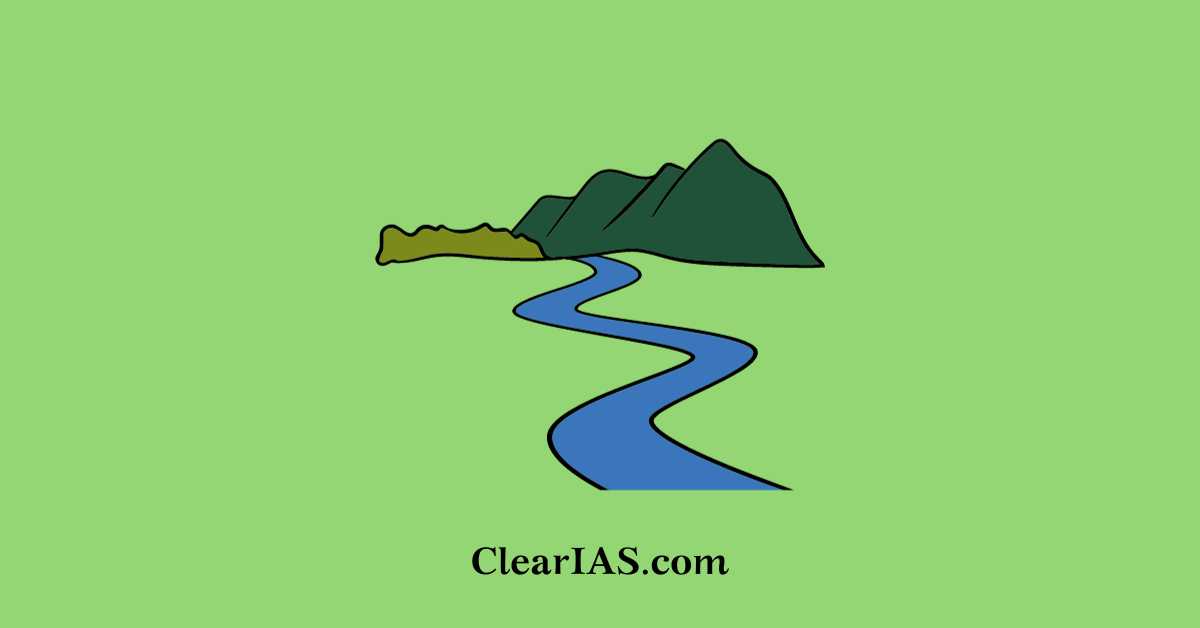
The Teesta River dispute makes headlines every time there is a bilateral talk between India and Bangladesh. The dispute is regarding the water sharing of River Teesta. Bangladesh wants a higher share than it has now. Currently, its share is lower than that of India’s. This article gives a broad insight into the river water sharing dispute, a timeline of various commissions formed, proposed alternative solutions, etc.
The Teesta River, which flows through India and Bangladesh, has been a source of contention between the two countries due to issues related to water sharing.
The dispute revolves around the equitable distribution of the river’s waters, particularly during the dry season, to meet the agricultural, drinking water, and other needs of both nations.
The Teesta River originates in the Himalayas and flows through the Indian states of Sikkim and West Bengal before entering Bangladesh and eventually emptying into the Bay of Bengal. The river is a crucial water resource for both India and Bangladesh.
Teesta River – States it passes through
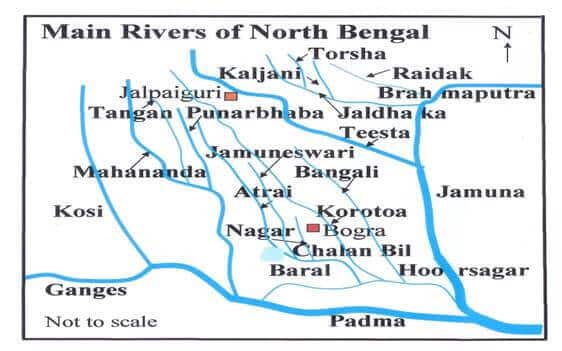
Teesta is a 414km long river flowing through the Indian states of West Bengal, and Sikkim before going to the Bay of Bengal through Bangladesh.
- It is the fourth largest transboundary river shared between India and Bangladesh after the Ganges, Brahmaputra, and Meghna river systems.
- Total catchment area: 1.75 million sq. km
Total length |
414km |
Sikkim |
151km |
Sikkim-West Bengal Boundary |
142km |
Bangladesh |
121km |
Importance of Teesta River to Bangladesh and West Bengal
For Bangladesh:
According to the report of the Asian Foundation in 2013, its floodplain covers about 14% of the total cropped area of Bangladesh and provides direct livelihood opportunities to approximately 73% of its population.
For West Bengal
Teesta is the lifeline of North Bengal and almost half a dozen districts of West Bengal are dependent on the waters of Teesta.
Teesta River Dispute – The Timeline of the Negotiation Events
- 1951: The then-East Pakistan (now Bangladesh) and India signed the ‘India-East Pakistan Agreement on the Sharing of the Ganges Waters,’ which included the Teesta River. The agreement provided for the equitable sharing of the river’s waters.
The negotiations on how to share the water have been going on since 1972.
- 1972: The Joint River Commission (JRC) was established by India and Bangladesh in the Indo-Bangla Treaty of Friendship.
- 1983: Agreement on ad hoc sharing of Teesta water. According to the agreement, ad hoc sharing is valid until 1985 end.
India |
39% |
Bangladesh |
36% |
Unallocated |
25% |
- 1984: According to 1984 JRC, Bangladesh’s share increased based on the hydrological data.
India |
42.5% |
Bangladesh |
37.5% |
Unallocated |
20% |
- 1998: Bangladesh started the “Teesta Barrage” irrigation project (3 cropping seasons per year).
- 2011: An interim deal that was supposed to last for 15 years – gave India 42.5% and Bangladesh 37.5% of Teesta water.
Note: However, West Bengal and Sikkim opposed an interim deal, since then the deal was shelved and remains unsigned due to the objections of West Bengal.
During Bangladesh Prime Minister Sheikh Hasina’s visit to India in December 2021, the leaders discussed the Teesta water-sharing issue. While no formal agreement was reached, there were indications of a renewed commitment to resolving the dispute.
The Federal Angle of the Teesta River Issue
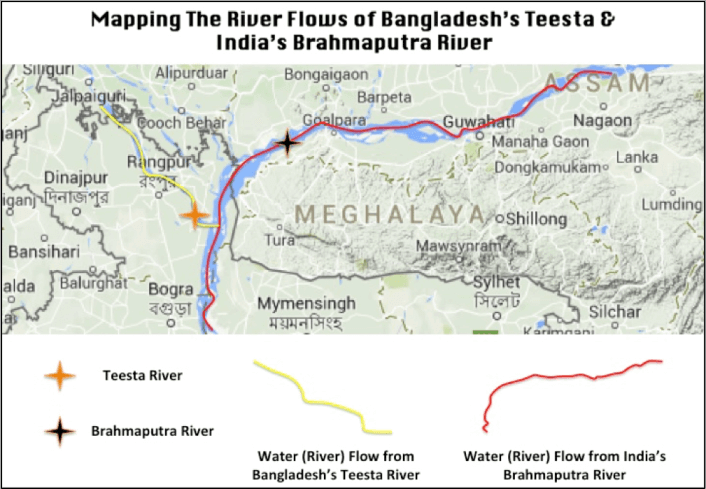
- Article 253 of the Indian Constitution gives power to the Union Government to enter any transboundary river water-related treaty with a riparian state.
- The center cannot do it arbitrarily without taking into consideration the social, political, and eco-impact of such a treaty in the catchment area.
- In 2011, the West Bengal government commissioned a study on the Teesta issue under the noted hydrologist Kalyan Rudra.
- This is not acceptable to Bangladesh, where the water is required mainly during the December – April period which is considered to be the leanest.
West Bengal’s Objection
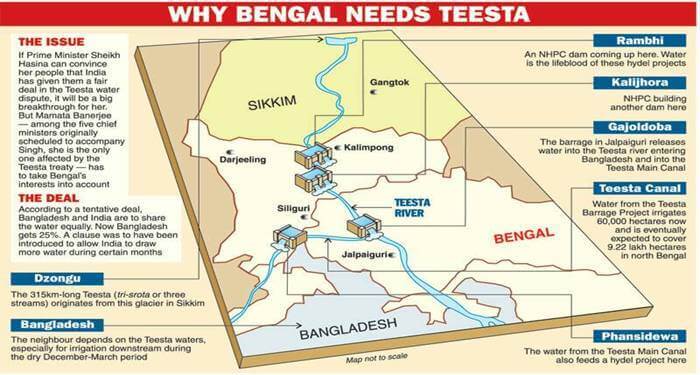
- Connection to global warming: Many of the glaciers on the Teesta river basin have retreated, says a strategic foresight group, a Mumbai think tank.
- Estimates suggest that Teesta River has a mean average flow of approximately 60 billion cubic meters, of which a significant amount flows during June and September, and October to April is considered to be a lean season.
- Any treaty will dry out the northern region of West Bengal and will hurt farmers.
- In 1998, Bangladesh’s Teesta barrage began, and the farmers of Bangladesh enjoyed 3 cropping seasons per year and didn’t deserve any more water.
- The project in West Bengal aims at irrigating 9,22,000 hectares of land in North Bengal and provides 67.60 MW of hydropower. Any water sharing with Bangladesh will hamper the project.
The Alternative solutions proposed by West Bengal
- Mamata Banerjee proposed sharing of rivers like the Torsa, which are closer to the border of Sikkim and Bangladesh.
- The Torsa has connectivity with Bangladesh’s Padma.
- She proposed that the two countries set up a commission to ascertain the level of water flowing through the Torsa and the quantum of water that can be shared.
Bangladesh’s Stand on the Teesta River Dispute
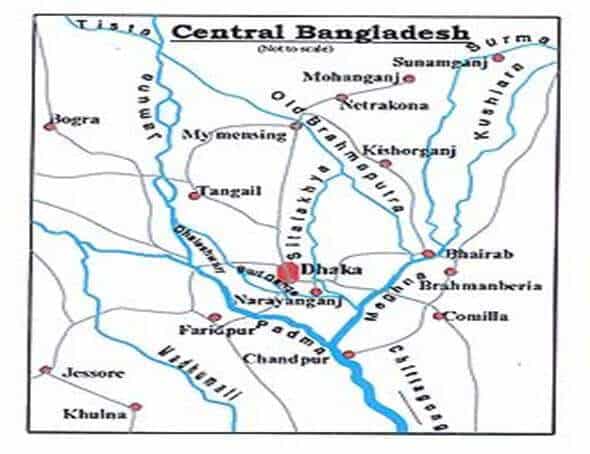
- India already enjoys a share of 55% of the river water.
- Bangladesh claims 50% of the water between December and May every year because that’s when the water flow to the country drops drastically.
- Over 1 lakh hectares of land in Rangpur – its rice bowl cannot be cultivated for winter crops due to excessive withdrawal of water by India.
- Bangladesh demands a fair share of river waters during the dry season.
Political Angle of Teesta River Dispute
- The previous Bangladesh Nationalist Party (BNP) govt. headed by Begum Khaleda Zia was not very receptive to India’s concern.
- The BNP, during its tenure in power between 1991-1996 and again from 2001 to 2006, provided shelter to leaders and cadres from various North East-based terror outfits.
- But Sheikh Hasina’s Bangladesh Awami League(BAL) party followed India-friendly policies and also adopted a zero-tolerance policy against anti-Indian terror outfits and eventually ULFA was banned.
- The cooperation between the two nations facilitated the finalization of the land boundary agreement.
- The Teesta River water deal as anticipated will help Delhi get more political leverage which it thinks is necessary to check the rising influence of China in the Bay of Bengal region.
Conclusion
- Bangladesh is a significant neighborhood for India with a shared history, culture, religion, and many more common elements.
- For Bangladesh, this issue is still considered to be a prolonged suffering inflicted by India.
- The cooperation of Bangladesh is important to India and without such liberal regimes in neighboring countries, India cannot become terror-free.
- Bangladesh is an essential element for India to get connected with North East.
- Considering the strategic importance of Bangladesh and as a responsible upper riparian state, India needs to take proactive steps for the early conclusion of the Teesta agreement.
Read: Transboundary rivers of India
Article by: P. Ujwala






awesome article
lucid and clear
Nice…
How the river water sharing is measured and if Bangladesh seeks more water why can’t the same claim be made by India?
Why in the winter time the flow is reduced?
In winter time the ice is not melted at the same rate as in summers.
thanks for the article Sir!
How much goodwill there is between Govts. of India and Bangladesh? Not much, I suppose.
Why I say so?
I think India is interested only to have her link with seven sister states through Bangladesh and keep China out of the country. India bother less for Bangladeshi people.
What present Bangladesh govt needs from India? Help to remain in power and ready to give anything India needs.
Crook governments both India and Bangladesh have. If honest and sincere govts they were, they could find reasonable solution to any problem. That is the fact. Otherwise why land-boundary treaty took over 40 years? And what sort of boundary is it? And, why there should be boarder killing even today?
For Share of Teesta river waters:
1. It should be based on areas in both countries which can be cultivated from its water.
2. Length of the river in both countries after leaving mountains, should be also given wattage while deciding share of waters.
3. No political consideration be considered for water sharing agreement.
4. China factor or terrorism hideouts, or location of Bangladesh should not be considered for water sharing agreement.
5. Daily based available water should be shared on daily basis.
6. Local farmers and residents right to the water is prime instead of political government considerations.